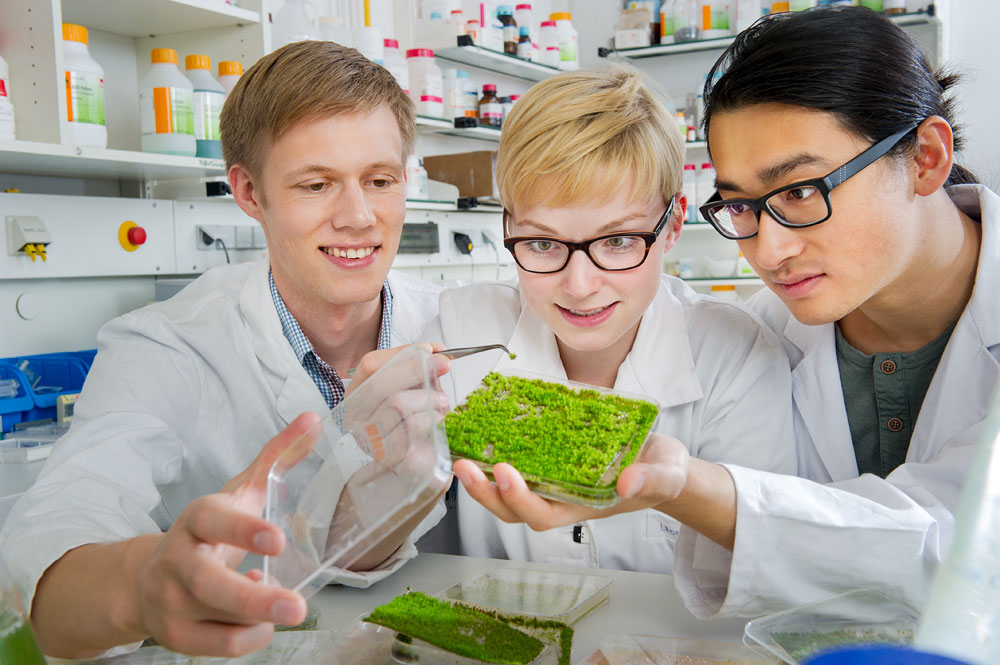Wastewater treatment with the PhyscoFilter:
Smart moss cleans water

The moss project was submitted to this year’s international iGEM Competition for Synthetic Biology, which will be held at the Massachusetts Institute of Technology (MIT) for the ninth time. The aim of the competition is to produce genetically modified organisms and thus create added value for society.
Breaking down and filtering: How to produce chemical-free water
The iGEM team is currently testing two ways of using moss to remove pollutants from the water: “Firstly, we are trying to get the moss to turn hazardous materials into harmless substances (biodegradation). Secondly, it is supposed to bind non-biodegradable substances and thus work as a filter (bioaccumulation),” explains Katrin Fischer, a student of Biochemistry in her fifth semester.
Both procedures rely on DNA blocks that are designed and implanted into the genetic material of the moss by the young researchers, in order to provide the genetic information that is needed for proteins to break down chemicals or to bind the contaminants. Thus, the moss can help to break down commonly found substances such as macrolide antibiotics or hormones from contraceptive pills. The moss can even absorb the insecticide DDT. Conventional wastewater treatment plants are not suitable to remove these substances adequately.
A genetic switch to protect surrounding ecosystems
“The Physcomitrella patens moss also works as an important water filter in nature – making it the ideal organism for our project,” says Fischer. The students’ project is primarily aimed at demonstrating that the moss can work as a filter – but they are also looking into potential practical applications.
The students also developed an equally simple but effective solution to ensure that the modified moss cannot contaminate the surrounding ecosystems: They use a type of moss with a mutation that keeps it from producing mature spores, and they also built in a self-destruction mechanism.
“This biological switch is sensitive to light in the red wavelength range,” explains Jeffery Truong, a master’s student of Molecular Biotechnology, who developed the filter. “To get the plant to grow, you use a light filter that specifically removes red light. If the plant accidentally migrates into surrounding areas, it will be exposed to sunlight which contains light of all wavelengths – so it cannot survive.”
A spotlight on synthetic biology
However, the technical and scientific feasibility is only one aspect of the iGEM project. The students also want to address the public with their moss filter and use it as a discussion-starter concerning the controversial topic of genetic engineering. Various activities are planned for this purpose, including an information booth at the Munich Science Days in November 2013 as well as events involving school pupils.
The team is also testing whether the “PhyscoFilter” can be used for industrial wastewater treatment, and have already developed a prototype. They are also conducting a feasibility study to explore the entrepreneurial potential of this promising idea.
Finals in Boston
The TUM students and their PhyscoFilter will be present at the competition finals in Boston (which will be held from November 1 to 3, 2013) after they recently managed the second place in the European qualifications in Lyon. 223 teams from all around the world are taking part in this year’s event.
The 2013 TUM iGEM team consists of 11 members, most of whom are students of Biochemistry or Molecular Biotechnology – but there are also students of Mathematics and Mechanical Engineering to round out the team. Truong explains that the researchers believe that their chances are quite good – as their project is not only ambitious regarding the technical issues:
“Water is the source of life. But the increasing use of chemicals is a threat to biodiversity and to several ecosystems. With our project, we want to contribute to protecting this valuable resource.”
by Barbara Wankerl
- Read more about the iGEM-Team of TUM